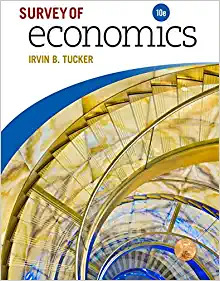Question
1/ In your answers to the following questions, be sure that you clearly articulate the reasoning you used to obtain your numerical answers: a. Suppose
1/ In your answers to the following questions, be sure that you clearly articulate the reasoning you used to obtain your numerical answers:
a. Suppose for the Canadian economy "the" multiplier is 3, the income multiplier with respect to the money supply is 4, and the money multiplier is 5. If the government decreases its spending by
i. $6 billion and directs the Bank of Canada to buy $2 billion worth of bonds, what will happen to the income level? (4 marks)
b. Suppose the Canadian economy, on a fixed exchange rate, is at a full employment equilibrium in which the long-run real rate of growth is 2%, and the real interest rate is 4%. In the United States, which you can consider to be the "rest-of-the-world," long-run real growth is 2%, the nominal interest rate is 8%, and the risk premium (Canada is riskier) is 1%. (6 marks)
i. What is Canada's inflation rate?
ii. What is Canada's nominal interest rate?
iii. Suppose now you are told that the exchange rate is flexible and that the value of the Canadian dollar is falling by 6% per year. What is Canada's inflation rate now?
c. Suppose the sum of consumption, investment, and government spending is $620 billion; the sum of income payments is $500 billion, including transfer payments of $5 billion; we imported $3 billion more than we exported; subsidies are $2 billion; depreciation is $70 billion; and indirect taxes are $62 billion. From this information, what is measured GDP? (4 marks)
2/ The following questions are worth 3 marks each:
a. Explain the crowding-out effect and why it makes an expansionary fiscal policy less effective.
b. "Several bond issues will raise $400 million, with the Bank of Canada picking up at least $200 million. The Bank of Canada can also be counted on to take down more of the bonds than the planned $200 million it has announced if they seem to be selling badly." i. What are the implications for the Canadian money supply when the Bank of Canada picks up $200 million of these bonds? ii. What does the second sentence imply about the Bank of Canada's monetary policy?
c. "Reacting to Thursday's flash second-quarter news that the U.S. economy has grown three whole percentage points, people were headed for the bond market exits." Explain why people would react this way to this news.
d. Why does an easy money policy lower the real interest rate but increase the nominal interest rate? (4marks) "Why has the governor of the Bank of Canada argued for a stable Canadian dollar and zero inflation? Aren't these inconsistent goals?" Explain why these goals are consistent or are inconsistent.
Step by Step Solution
There are 3 Steps involved in it
Step: 1

Get Instant Access to Expert-Tailored Solutions
See step-by-step solutions with expert insights and AI powered tools for academic success
Step: 2

Step: 3

Ace Your Homework with AI
Get the answers you need in no time with our AI-driven, step-by-step assistance
Get Started


